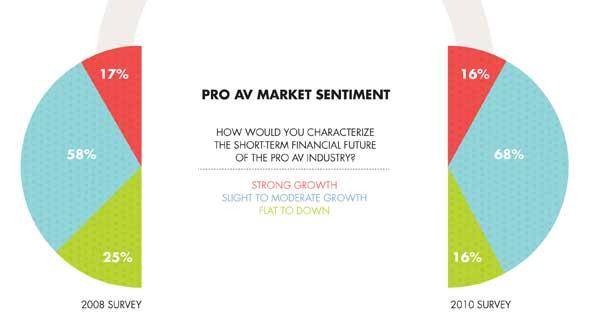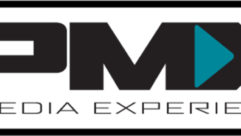

PRO AV Forecast 2011: Silver Linings
No one claims the AV industry is out of the woods, but most agree the worst is behind us?and the future’s a new ballgame.
Andreas Watt, CTS, is on his cell phone, driving to an AV job in the Denver area. A selfdescribed military kid, he’s “heading into battle,” as he puts it, in order to keep his fi ve-man shop competitive in a slowly healing economy. “I love installing—love it,” says the owner of Xcite Audiovisuals in Centennial, Colo. “If something goes wrong, I don’t just send my guys out there to fi x it. I’m out there with them in the trenches.”
It’s a professional philosophy that served Xcite AV well when the nation slipped into recession in December 2007 (unbeknownst to much of the pro AV industry, until its effects were felt months later). In fact, Watt says, Xcite AV didn’t feel much impact from the economic crisis, and now the company’s laser focus on customer service and willingness to chase even the smallest AV projects could prove a roadmap for other integrators navigating their way out of the business doldrums.
“It seemed like lots of guys put their eggs in one basket, either large commercial projects with general contractors or, in the residential market, large custom homes that cost $4 million,” Watt says. “We had guys just doing basement renovations, which was good business.”
In the commercial market, Xcite AV took a new contract with MillerCoors and ran with it. “We got MillerCoors right when the economy went bad and things were really tight,” Watt explains. “But they still had plenty of little jobs for us and we treated them like big jobs. Being a chameleon in the industry helped a lot.”
“Adaptability” might be the word of the year for AV integrators. Because pro AV is largely at the mercy of others–commercial construction, corporate clients, school and government budgets–successful AV firms learn to roll with the punches. The good news, according to Pro AV’s latest forecast survey, is that the industry is more optimistic about the future. Companies are adjusting to short-term realities, such as taking on more small jobs, and they’re slowly filling their pipelines with work.
“When we look at our business and talk to our customers and the influencers around us, we’re busy and they’re busy,” says Steve Metzger, president of Biamp Systems. “There’s certainly some caution, but right now we’re very optimistic.”
New Realities
The industry was similarly optimistic more than two years ago when Pro AV conducted its first forecast survey (“The Road Ahead,” December 2008). In that study, 63 percent of AV prosincluding integrators and installers, consultants, dealers and distributors, rental and staging firms, and AV manufacturers–expected more revenue in 2009 than they generated in 2008. That was before the AV market felt the full brunt of the recession. This time, in a survey fielded in late November 2010, 69 percent said they expect a rosier 2011.
“Given the state of the economy, business is okay. We’ve survived well,” says Sue Lepp, senior vice president at Lorton, Va.based Design and Production (D&P). According to Lepp, D&P has a healthy backlog of larger design/build contracts for 2012 and 2013. “For 2011 we’re filling in some holes,” she says.
What happened to AV companies between 2008 and 2010, when by most accounts it wasn’t business as usual? And how will that affect their recovery? In interviews with AV professionals about how they see the market, they all agree that AV technology remains in high demand from organizations that recognize the need for new ways of communicating, engaging audiences, and better running their businesses. Those same organizations are also more careful with their money, and some need help in maintaining their AV systems. That means that many AV companies are adjusting their mix of products and services.
“We went out and chased jobs over the last 18 months that we normally wouldn’t have gone after,” says Lepp, whose company specializes in museum installations. “As far as AV goes, the smaller jobs are not as complex. They may not be centralized. There may be a lot of standalone interactive kiosks or maybe a single theater. And it’s not surprising to see what would have been a projection system turned into a 60-inch flat-screen.”
In the 2011 Forecast Survey, AV pros who’d seen a recent increase in revenue were asked to cite the single biggest reason for that increase. In a significant change from two years ago, 40 percent said the reason was that their company was handling more work than before, but only 10 percent said it was because the jobs they handled were bigger. In 2008 when Pro AV asked the question, only 26 percent said it was because they had more work and 20 percent said it was due to bigger jobs.
PRO AV Forecast 2011: Silver Linings
No one claims the AV industry is out of the woods, but most agree the worst is behind us?and the future’s a new ballgame.
Michael Fay, general manager of Escondido, Calif.based Sound Image’s contracting division, said the company is putting more bids on the street to get back to healthy revenue levels. Despite the recession, Fay says 2009 was a strong year for Sound Image. Most of 2010 was, too. It wasn’t until the fourth quarter of 2010 that business hit the brakes, falling 50 percent from prerecession highs.
“But we’re already seeing more opportunities the first few weeks of 2011 than we saw at the end of last year,” Fay says. What’s different now, though, is the nature of competition. Specifically from companies pitching low-ball bids.”
“Once upon a time, when we bid on a project, most of the bidders were within about 10 percent of each other,” Fay says. “Now we’re seeing 50 percent swings.”
On public bids, where all bidders are permitted to see each other’s final numbers, Sound Image conducts what Fay calls an “autopsy” or a “bid post-mortem” and tries to figure out how it could have matched the lowest bidder. Assuming they haven’t made mistakes in their bids, he says, it often requires taking their markups down to zero.
“Competition’s fierce for the smaller jobs,” agrees Lepp. “You have a lot more smaller companies bidding that don’t have the same overhead we have, and we’ve seen a lot of low-balling.”
A ripple effect of low-ball offers, and something AV integrators would be wise to alert potential clients about, is the fact the if a low-ball contractor goes out of business before the project is done, it may be hard to find a replacement to finish the job on remotely similar terms. (Fay says that this can be a problem with other contractors, too, such as mechanical contractors, which only serves to delay or sometimes doom a project.)
But low-balling can also be symptomatic of a revenue opportunity. When organizations are cost-conscious, they may also be strapped for maintenance resources. Because the cost of equipment and the cost of ongoing support often come from different budgets, AV pros would do well to pivot toward operations managers. For Lepp and D&P, service revenue has tripled in the last two years and the company now carries a dozen large contracts.
“That’s another phase of our business that’s making a positive turn: As facilities have had to cut their staffs, they are outsourcing more maintenance,” Lepp says.
The company only pitches service contracts to clients it has done AV installations for, but those contracts can encompass more than D&P-provided systems. For example, at the Smithsonian Institution’s Museum of Natural History, D&P installed three exhibits. It then bid on a multiyear contract to provide maintenance service because the museum had cut staff. D&P now has techs in the museum three days a week. “We’re very familiar with their systems,” Lepps says. “And we picked up general AV and lighting maintenance work.”
Standing Out
Offering support services has been a differentiator for D&P. In challenging times, standing out can make all the difference. Several AV pros say being able to get bonded on a project that might require such assurances is especially attractive these days. Others say knowing when to go the extra mile to impress a client is also important.
“Maybe it’s our residential background, but if someone calls and a Cat-5 jack isn’t working–and people tell me I’m crazy to do this–I’ll walk out and say, ‘It’s no charge this time,'” Watt says.
For Sound Image, being versed in the language of today’s construction professionals has given the company an advantage. “We’ve been a Revit-certified low-voltage contractor for 3.5 years when a lot of people in our area don’t know what Revit is,” Fay says. (It’s a type of building information modeling software from Autodesk, the developers of AutoCAD.) “That’s helping us get on short lists because one of the prequalification items that’s starting to separate some contractors from others is their ability to participate in BIM coordination of a project.”
Where will AV pros find the most project activity this year? “Education will continue to be strong,” says Biamp’s Metzger. “When you talk to people at the university and community college level you get a sense of just how strong their enrollments are and how competitive those spaces have become. As the economy turns, they understand they need to update their learning and education.”
With an aging population, experts believe that more healthcare facilities will also be in the market for new technology this year. And everyone will be looking for more than just AV. In the forecast survey, a great share of respondents expect to be involved with building control, security, content distribution, and energy management than just a couple years ago.
Which brings Xcite’s Watt to one last strategy for growing his business: training. “You can’t take enough classes,” he says, “because you can’t ever have your client come to you for something and answer, ‘I’ve never done that before.'”
Words from the wise.
PRO AV Forecast 2011: Silver Linings
No one claims the AV industry is out of the woods, but most agree the worst is behind us?and the future’s a new ballgame.










